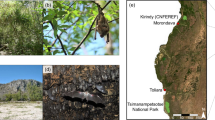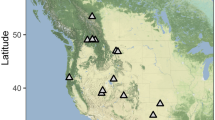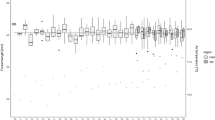Abstract
Species with broad geographic ranges may experience varied environmental conditions throughout their range leading to local adaptation. Variation among populations reflects potential adaptability or plasticity, with implications for populations impacted by disease, climate change, and other anthropogenic influences. However, behavior may counteract divergent selection among populations. We studied intraspecific variation in hibernation physiology of Myotis lucifugus (little brown myotis) and Corynorhinus townsendii (Townsend’s big-eared bat), two species of bats with large geographic ranges. We studied M. lucifugus at three hibernacula which spanned a latitudinal gradient of 1500 km, and C. townsendii from 6 hibernacula spread across 1200 km latitude and 1200 km longitude. We found no difference in torpid metabolic rate among populations of either species, nor was there a difference in the effect of ambient temperature among sites. Evaporative water loss was similar among populations of both species, with the exception of one C. townsendii pairwise site difference and one M. lucifugus site that differed from the others. We suggest the general lack of geographic variation is a consequence of behavioral microhabitat selection. As volant animals, bats can travel relatively long distances in search of preferred microclimates for hibernation. Despite dramatic macroclimate differences among populations, hibernating bats are able to find preferred microclimate conditions within their range, resulting in similar selection pressures among populations spread across wide geographic ranges.



Similar content being viewed by others
Data availability
Data will be submitted to Dryad Data Repository prior to publication.
Abbreviations
- TMR:
-
Torpid metabolic rate
- EWL:
-
Evaporative water loss
- WVP:
-
Water vapor pressure
- \(\dot{\mathrm{V}}{\mathrm{CO}}_{2}\) :
-
Rate of carbon dioxide production
References
Arguez A, Durre I, Applequist S, Vose RS, Squires MF, Yin X, Heim RR Jr, Owen TW (2012) NOAA’s 1981–2010 US climate normals: an overview. Bull Am Meteor Soc 93(11):1687–1697
Auteri GG, Knowles LL (2020) Decimated little brown bats show potential for adaptive change. Sci Rep 10(1):1–10
Ben-Hamo M, Muñoz-Garcia A, Williams JB, Korine C, Pinshow B (2013) Waking to drink: rates of evaporative water loss determine arousal frequency in hibernating bats. J Exp Biol 216(4):573–577
Boratyński JS, Willis CK, Jefimow M, Wojciechowski MS (2015) Huddling reduces evaporative water loss in torpid Natterer’s bats, Myotis nattereri. Comp Biochem Physiol A 179:125–132
Boyles JG, Dunbar MB, Storm JJ, Brack V Jr (2007) Energy availability influences microclimate selection of hibernating bats. J Exp Biol 210:4345–4350. https://doi.org/10.1242/jeb.007294 (Pt 24)
Boyles JG, Johnson JS, Blomberg A, Lilley TM (2020) Optimal hibernation theory. Mammal Rev 50(1):91–100
Boyles JG, McKechnie AE (2010) Energy conservation in hibernating endotherms: why “suboptimal” temperatures are optimal. Ecol Model 221(12):1644–1647
Brunet-Rossinni AK, Wilkinson GS (2009) Methods for age estimation and the study of senescence in bats. In: Kunz TH, Parsons S (eds) Ecological and behavioral methods for the study of bats, 2nd edn. Johns Hopkins University Press, Baltimore, pp 315–325
Buckley LB, Ehrenberger JC, Angilletta MJ Jr (2015) Thermoregulatory behaviour limits local adaptation of thermal niches and confers sensitivity to climate change. Funct Ecol 29(8):1038–1047
Burns LE, Frasier TR, Broders HG (2014) Genetic connectivity among swarming sites in the wide ranging and recently declining little brown bat (Myotis lucifugus). Ecol Evol 4(21):4130–4149
Czenze ZJ, Park AD, Willis CK (2013) Staying cold through dinner: cold-climate bats rewarm with conspecifics but not sunset during hibernation. J Comp Physiol B 183(6):859–866. https://doi.org/10.1007/s00360-013-0753-4
Czenze ZJ, Jonasson KA, Willis CK (2017) Thrifty females, frisky males: winter energetics of hibernating bats from a cold climate. Physiol Biochem Zool 90(4):502–511
Davis WH (1966) Population dynamics of the bat Pipistrellus subflavus. J Mammal 47(3):383–396
Doebeli M, Dieckmann U (2003) Speciation along environmental gradients. Nature 421(6920):259–264
Dunbar MB, Brigham RM (2010) Thermoregulatory variation among populations of bats along a latitudinal gradient. J Comp Physiol B 180(6):885–893
Environment and Climate Change Canada (2020). https://climat.meteo.gc.ca/climate_normals/index_e.html
Fenton MB (1969) Summer activity of Myotis lucifugus (Chiroptera: Vespertilionidae) at hibernacula in Ontario and Quebec. Can J Zool 47(4):597–602
Fenton MB, Barclay RMR (1980) Myotis lucifugus. Mamm Species 142:1–8
Fleming TH, Eby P (2003) Ecology of bat migration. In: Kunz TH, Fenton MB (eds) Bat ecology. University of Chicago Press, Chicago, pp 156–208
Frick WF, Reynolds DS, Kunz TH (2010) Influence of climate and reproductive timing on demography of little brown myotis Myotis lucifugus. J Anim Ecol 79(1):128–136
Garland T Jr, Adolph SC (1991) Physiological differentiation of vertebrate populations. Annu Rev Ecol Syst 22(1):193–228
Gearhart C, Adams AM, Pinshow B, Korine C (2020) Evaporative water loss in Kuhl’s pipistrelles declines along an environmental gradient, from mesic to hyperarid. Comparat Biochem Physiol Part A 240:110587
Gould SJ, Johnston RF (1972) Geographic variation. Annu Rev Ecol Syst 3(1):457–498
Griffin DR (1970) Migrations and homing of bats. In: Wimsatt WA (ed) Biology of bats, vol 1. Academic Press, New York, pp 233–264
Grolemund G, Wickham H (2011) Dates and times made easy with lubridate. J Stat Softw 40(3):1–25
Haase CG, Fuller NW, Hranac CR, Hayman DT, McGuire LP, Norquay KJ, Silas KA, Willis CK, Plowright RK, Olson SH (2019) Incorporating evaporative water loss into bioenergetic models of hibernation to test for relative influence of host and pathogen traits on white-nose syndrome. PLoS ONE 14(10):e0222311
Hothorn T, Bretz F, Westfall P (2008) Simultaneous inference in general parametric models. Biom J 50(3):346–363
Hranac CR, Haase CG, McClure MM, Lausen CL, McGuire LP, Fuller NW, Marshall JC, Olson SH, Hayman DT (2021) What is winter? Modelling spatial variation in bat host traits and hibernation and their implications for overwintering energetics. Ecol Evol. https://doi.org/10.1002/ece3.7641
Hughes SE (1968) Temperature of the bat, Plecotus townsendii, during arousal. J Mammal 49(1):140–142
Humphrey SR, Kunz TH (1976) Ecology of a Pleistocene relict, the western big-eared rat (Plecotus townsendii), in the Southern Great Plains. J Mammal 57(3):470–494
Humphries MM, Thomas DW, Speakman JR (2002) Climate-mediated energetic constraints on the distribution of hibernating mammals. Nature 418(6895):313–316
Ingersoll TE, Navo KW, de Valpine P (2010) Microclimate preferences during swarming and hibernation in the Townsend’s big-eared bat, Corynorhinus townsendii. J Mammal 91(5):1242–1250
Jonasson KA, Willis CK (2011) Changes in body condition of hibernating bats support the thrifty female hypothesis and predict consequences for populations with white-nose syndrome. PLoS ONE 6(6):e21061
Jonasson KA, Willis CK (2012) Hibernation energetics of free-ranging little brown bats. J Exp Biol 215:2141–2149. https://doi.org/10.1242/jeb.066514 (Pt 12)
Kahle D, Wickham H (2013) ggmap: spatial visualization with ggplot2. R J 5(1):144–161
Kawecki TJ, Ebert D (2004) Conceptual issues in local adaptation. Ecol Lett 7(12):1225–1241
Klüg-Baerwald BJ, Brigham RM (2017) Hung out to dry? Intraspecific variation in water loss in a hibernating bat. Oecologia 183(4):977–985
Kunz TH, Martin RA (1982) Plecotus townsendii. Mamm Species 175:1–6
Kunz TH, Wrazen JA, Burnett CD (1998) Changes in body mass and fat reserves in pre-hibernating little brown bats (Myotis lucifugus). Ecoscience 5(1):8–17
Lentini PE, Bird TJ, Griffiths SR, Godinho LN, Wintle BA (2015) A global synthesis of survival estimates for microbats. Biol Lett 11(8):20150371
Lighton JR (2018) Measuring metabolic rates: a manual for scientists. Oxford University Press (Oxford)
McClure ML, Crowley D, Haase CG, McGuire LP, Fuller NW, Hayman DT, Lausen CL, Plowright RK, Dickson BG, Olson SH (2020) Linking surface and subterranean climate: implications for the study of hibernating bats and other cave dwellers. Ecosphere 11(10):e03274
McGuire LP, Fenton MB, Guglielmo CG (2009) Effect of age on energy storage during prehibernation swarming in little brown bats (Myotis lucifugus). Can J Zool 87(6):515–519. https://doi.org/10.1139/z09-041
McGuire LP, Mayberry HW, Willis CK (2017) White-nose syndrome increases torpid metabolic rate and evaporative water loss in hibernating bats. Am J Physiol-Regulat Integr Comparat Physiol 313(6):R680–R686
Norquay KJO, Willis CKR (2014) Hibernation phenology of Myotis lucifugus. J Zool 294(2):85–92. https://doi.org/10.1111/jzo.12155
Norquay KJ, Martinez-Nuñez F, Dubois JE, Monson KM, Willis CK (2013) Long-distance movements of little brown bats (Myotis lucifugus). J Mammal 94(2):506–515
Otto SP (2018) Adaptation, speciation and extinction in the Anthropocene. Proc R Soc B 285(1891):20182047
Perry RW (2013) A review of factors affecting cave climates for hibernating bats in temperate North America. Environ Rev 21(1):28–39. https://doi.org/10.1139/er-2012-0042
Perry RW, Saugey DA, Crump BG (2010) Winter roosting ecology of silver-haired bats in an Arkansas forest. Southeast Nat 9(3):563–572
Pinheiro J, Bates D, DebRoy S, Sarkar D, R Core Team (2020) nlme: linear and nonlinear mixed effects models. R package version 3.1-144. https://CRAN.R-project.org/package=nlme
Price ER, Mager EM (2020) Respiratory quotient: effects of fatty acid composition. J Exp Zool Part A 333(9):613–618
R Core Team (2020) R: a language and environment for statistical computing. R Foundation for Statistical Computing, Vienna
Ransome R (1968) The distribution of the greater horse-shoe bat, Rhinolophus ferrum-equinum, during hibernation, in relation to environmental factors. J Zool 154(1):77–112
Rousset F (1997) Genetic differentiation and estimation of gene flow from F-statistics under isolation by distance. Genetics 145(4):1219–1228
Sherwin RE, Stricklan D, Rogers DS (2000) Roosting affinities of Townsend’s big-eared bat (Corynorhinus townsendii) in northern Utah. J Mammal 81(4):939–947
Thomas D, Geiser F (1997) Periodic arousals in hibernating mammals: is evaporative water loss involved? Funct Ecol 11(5):585–591
Thomas DW, Cloutier D (1992) Evaporative water loss by hibernating little brown bats, Myotis lucifugus. Physiol Zool 65(2):443–456
Thomas DW, Dorais M, Bergeron J-M (1990) Winter energy budgets and cost of arousals for hibernating little brown bats, Myotis lucifugus. J Mammal 71(3):475–479
US Fish and Wildlife Service (2018) National white-nose syndrome decontamination protocol. www.WhiteNoseSyndrome.org
Wickham H, François R, Henry L, Müller K (2021) dplyr: a grammar of data manipulation. R Package Version 1.0.6. https://CRAN.R-project.org/package=dplyr
Willis CK (2015) Conservation physiology and conservation pathogens: white-nose syndrome and integrative biology for host–pathogen systems. Integr Comp Biol 55(4):631–641
Willis CKR, Menzies AK, Boyles JG, Wojciechowski MS (2011) Evaporative water loss is a plausible explanation for mortality of bats from white-nose syndrome. Integr Comp Biol 51(3):364–373. https://doi.org/10.1093/icb/icr076
Wilson JM, Reimer JP, Allaire D, Lausen CL (2014) Diversity and distribution of bats in the Northwest Territories. Northwest Nat 95(3):197–218
Zuur A, Ieno EN, Walker N, Saveliev AA, Smith GM (2009) Mixed effects models and extensions in ecology with R. Springer Science and Business Media, New York
Acknowledgements
We appreciate all colleagues on our team that contributed to ongoing discussion of the ideas and related aspects of the research we present here, including Meredith McClure, David Hayman, Reed Hranac, Raina Plowright, Brett Dickson, Emily Johnson, and Emma Kunkel. Field research spanning 9 sites in 8 states/provinces and 2 countries is a daunting challenge, and would not have been possible without assistance provided by a long list of individuals that provided crucial support with logistic coordination, and fieldwork and permitting support. We are grateful to all those that supported our research, including Lindsay Anderson, Dan Bachen, Charlene Barker, David Bishop, Fauve Blanchard, Dave Bobbit, German Botto, Ellen Brandell, Adam Brewerton, Joanna Burgar, Connie Campbell, Muriel Chahine, Dave Critchley, Jurgen Deagle, Kevin Downing, Orville Dyer, Troy Ellsworth, Heather Fenton, Steve Fox, Heather Gates, Danika Gerylo, Purnima Govindarajulu, Imogen Grant-Smith, Konstantin von Gunten, Marie-Helene Hamel, Lauri Hanauska-Brown, Jason Headley, Dave Hobson, Danica Hogan, Greg Horne, Anna Magdalena Hubmann, Sharon Irwin, Tina Jackson, Devin Jones, Kellen Keisling, Allicia Kelly, Mike Kelly, Paul Knaga, Eli Lee, Erin Low, Kelsey Low, Brandon Mackinnon, Bryce Maxell, Ryan McKay, Katie McNab, Dan Neubaum, Cory Olson, Felix Ossig-Bonanno, Lori Parker, Cochise Paulette, Vladimir Paulik, Evan Phillips, Chuck Priestley, Jason Rae, John Roth, Maria-Camila Roy-Avilan, Frank Schlichting, Jenna Schulhof, Helen Schwantje, Todd Shury, Lisa Sims, Geoff Skinner, Erin Tattersal, Dylan Taylor, Nina Veselka, Lisa Wilkinson, Jason Williams, Joanna Wilson, Masako Wright, Ivan Yates, and Vladimir Zumorin.
Funding
This project was funded in part with Federal funds from the Department of Defense Strategic Environmental Research and Development Program, under Contract Number W912HQ-16-C-0015. Any opinions, findings, and conclusions or recommendations expressed in this publication are those of the authors and do not necessarily reflect the views of the United States government. Additional funding was provided by the United States Fish and Wildlife Service (CFDA program 15.657 grant F17AP00593), Texas Tech University, and the Alberta Conservation Association.
Author information
Authors and Affiliations
Contributions
LPM, SHO, and CLL conceived the study. LPM, SHO, CLL, and CKRW secured the funding. NWF, CGH, KAS, and YAD collected the data. LPM analyzed the data and drafted the manuscript. All the authors contributed editorial comments on the manuscript.
Corresponding author
Ethics declarations
Conflict of interest
The authors declare no conflicts of interest or competing interests.
Ethical approval
All the procedures conducted in the United States were approved by the Texas Tech University Institutional Animal Care and Use Committee (protocol 16031-05). All the procedures conducted in Canada conformed to the guidelines of the Canadian Council on Animal Care and were permitted by Alberta Environment and Parks (17-214 and 18-016), British Columbia Ministry of Forest Lands Natural Resource Operations and Rural Development (MRCB15-163558), Northwest Territories Department of Environment and Natural Resources (WL500648), Government of Northwest Territories Wildlife Care Committee (NWTWCC 2018-015), and Parks Canada (WB2018-020 and WB-2018-28777). Permits for fieldwork in the United States were obtained from the Montana Department of Fish, Wildlife and Parks (2016-104, 2017-018, and 2018-008), Colorado Parks and Wildlife (16TR2172, 17TR2172, 18TR2172, and 19TR2172), Nevada Department of Wildlife (497636), Utah Division of Wildlife Resources (2COLL10094), and National Park Service (ORCA-2018-SCI-0001).
Additional information
Communicated by K.H. Dausmann.
Publisher's Note
Springer Nature remains neutral with regard to jurisdictional claims in published maps and institutional affiliations.
Rights and permissions
About this article
Cite this article
McGuire, L.P., Fuller, N.W., Dzal, Y.A. et al. Similar hibernation physiology in bats across broad geographic ranges. J Comp Physiol B 192, 171–181 (2022). https://doi.org/10.1007/s00360-021-01400-x
Received:
Revised:
Accepted:
Published:
Issue Date:
DOI: https://doi.org/10.1007/s00360-021-01400-x




